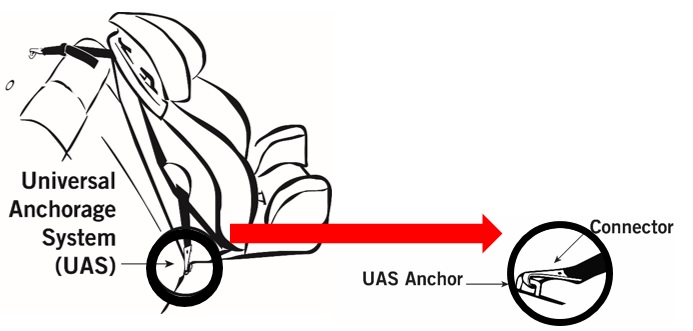When used correctly, car seats and booster seats save lives and reduce injuries. Children can get hurt if their car seats or booster seats are not used properly.
Here are some tips on how to use the tether strap for all forward-facing car seats and how to use the universal anchorage system (UAS) to secure any car seat in your vehicle.
All car seats are safest in the back seat.
Tether strap
When used forward-facing, a car seat must be held in place with both a tether strap and either the UAS or the seat belt.
The tether strap is on the back of the car seat. It must be hooked to a tether anchor in the vehicle.
Always use the tether strap when installing your child’s forward-facing car seat. If a tether strap isn’t used, your child is more likely to be hurt in a crash, as their head will move dangerously forward.
Check your car seat instructions to find the tether strap and hook, and to learn how to attach and tighten the tether strap. The tether strap must be tight. It may need to be doubled back to prevent it from slipping or coming undone.
Tether anchors
Check the section on car seat installation in your vehicle owner's manual to find where the tether anchors are in your vehicle. Tether anchors may be marked with this symbol in your vehicle:

Never attach more than one car seat to the same tether anchor.
|
|
Universal anchorage system (UAS)

Vehicles made after 2002 have lower UAS anchor bars. These UAS anchor bars are found between the back of the seat and the seat cushion. Check your vehicle owner's manual to find these anchor bars and to learn how to use them.
All new car seats come with a UAS belt and connectors.
Using the UAS is recommended when there are lower UAS anchor bars in the seat where you want to install the car seat. Using the UAS is easier than using a seat belt and can help you get a tighter, safer fit.
Seats in your vehicle with UAS anchor bars may be marked with this symbol:

When using the UAS for your car seat:
- Check your vehicle owner's manual to find the UAS anchor bars.
- Check the labels on the car seat or the car seat instructions to find the correct path for the UAS belt.
- Attach the connectors of the UAS belt on your car seat to the vehicle’s UAS anchor bars.
- Push down on the car seat and tighten the UAS belt.
- For forward-facing car seats, attach the tether strap to the tether anchor and tighten.
The car seat should move less than 2.5 cm (1 inch) in any direction.
Learn more about installing and using a car seat with the YES Test self-check tools:
UAS and the centre back seat
Many vehicles do not have UAS for the centre back seat. Check your vehicle owner's manual to find the UAS anchor bars in your vehicle. If the centre seat does not have UAS locations, use the seat belt to secure the car seat.
UAS maximum weight
Check your vehicle owner’s manual and the car seat instructions for guidelines about the maximum weight allowed for the UAS. If your child weighs 18 kg (40 lb.) or more and no UAS guidelines are given in your vehicle or the car seat’s instructions, use the UAS and seat belt and the tether strap to install your car seat.
Read your car seat or booster seat instructions and your vehicle owner’s manual to make sure you are using the seat properly. Make every ride a safe ride for everyone.
If you still have questions, call Health Link at 811.
